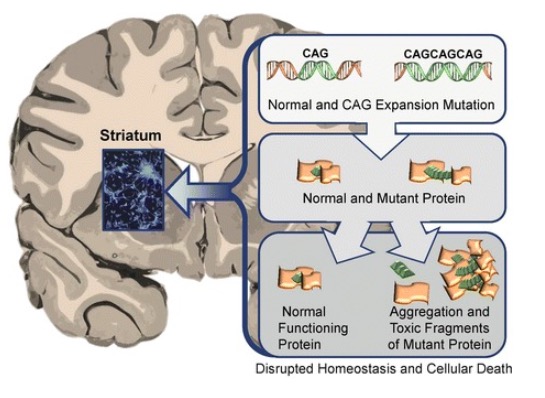Playlist
Show Playlist
Hide Playlist
Clinical Correlations: Huntington's Disease
-
Slides 14 BasalGanglia BrainAndNervousSystem.pdf
-
Reference List Anatomy.pdf
-
Download Lecture Overview
00:00 Another area that relates to basal ganglia disorders would be Huntington’s disease. Huntington’s disease is going to alter the direct pathway as well as the indirect pathway. So here we see the direct pathway. 00:21 What happens here is in the direct pathway, you’ll have a loss of GABAergic striatal neurons in this pathway. 00:31 These are the neurons coming in through here. As a result of that loss, you have a loss of inhibitory influence on the globus pallidus. This then will inhibit the thalamus. If the thalamus is inhibited, the cortex will be understimulated. If you think about the math again, we’ve lost a color. But again, this was a minus one inhibitory. This was a minus one inhibitory. And this is a plus one. Well here, we’ve lost this first inhibitory influencer of the pathway, of the circuit and have this inhibitor and this as being an excitor. 01:16 So minus one times a plus one gives you a minus one and so, that then gives you this under excitation. 01:25 Huntington’s disease also has an influence on the indirect pathway. Here again, loss of the GABAergic striatal neurons will impact the processing or the circuitry here. As a result, there’ll be a loss of inhibitory influence of the indirect pathway. So, if you lose your inhibitory influence then now, you can over excite your motor cortex. Individuals with Huntington’s will execute motor programs with actually having no control over that execution. Again, this all relates to math. As you may recall, we had more negative influencers by one over positive influencers in this pathway. So if you lose one of those influencers and you had the same number of negative influencers and positive influencers, you then still end up with a positive or excitatory effect on the cerebral cortex. Here we’re looking at a table that’s going to identify some of the symptoms of Huntington’s disease as well as structural changes and causes. 02:47 Let’s take a look at some of the symptoms that are associated with Huntington’s disease. The first is chorea. Athetosis is another symptom. Individuals manifest or exhibit personality changes. 03:07 Individuals with Huntington’s disease demonstrate dementia. Structural changes: loss of GABAergic neurons. These are going to be medium sized, spiny neurons from the striatum. Those are the ones that are impacted or lost. The ventricles will enlarge or expand. This is a genetic disorder that’s autosomal dominant. What we see genetically is there’s an excessive repeat of three nucleotides: C, G, and A.
About the Lecture
The lecture Clinical Correlations: Huntington's Disease by Craig Canby, PhD is from the course Basal Ganglia.
Included Quiz Questions
Which of the following is an effect of Huntington's disease on direct pathways?
- Loss of GABAergic striatal neurons
- Disinhibition of the thalamus
- Overstimulation of the cortex
- Loss of glutaminergic neurons in the nigrostriatal pathway
- Loss of excitatory influence on the globus pallidus internus
Which of the following statements regarding Huntington's disease is NOT true?
- Personality changes are rarely found.
- Ventriculomegaly is noted on imaging studies.
- It exhibits phenomenon of anticipation.
- It has an autosomal dominant pattern of inheritance.
- CAG trinucleotide is repeated excessively.
Which of the following would be caused by loss of inhibitory influence of an indirect pathway?
- Lack of control over motor programs
- Difficulty initiating movements
- Inhibition of the subthalamic nucleus
- Inhibition of the thalamus
- Inhibition of the motor cortex
Customer reviews
1,0 of 5 stars
| 5 Stars |
|
0 |
| 4 Stars |
|
0 |
| 3 Stars |
|
0 |
| 2 Stars |
|
0 |
| 1 Star |
|
1 |
lack of structure just got messy. it can be done in a much better way to follow the different pathways




